Apollo 8
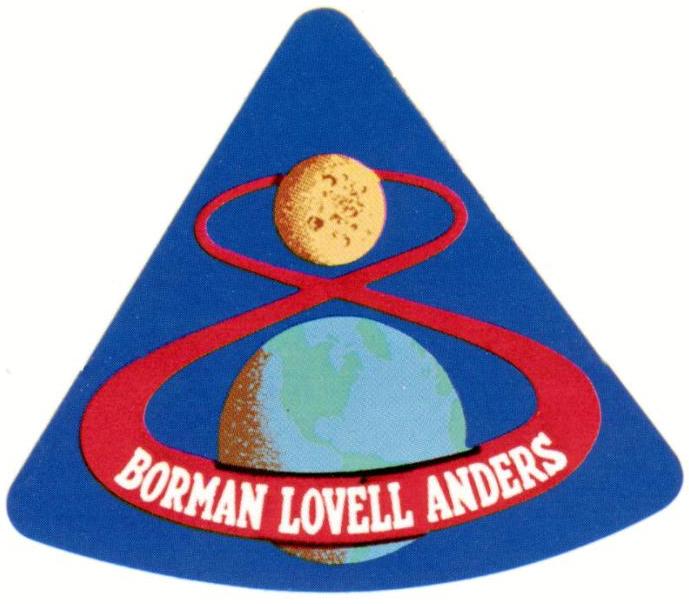
Crew
Frank Borman Commander
William A. Anders Lunar Module Pilot
James A. Lovell Jr. Command Module Pilot
Backup Crew
Neil Armstrong
Commander
Fred W. Haise Jr.
Lunar Module Pilot
Edwin E. Aldrin Jr.
Command Module Pilot
Payload
CSM-103
Prelaunch Milestones
12/24/67 - S-II stage ondock at Kennedy
12/27/67 - S-IC stage ondock at Kennedy
12/30/67 - S-IVB ondock at Kennedy
1/4/68 - S-IU ondock at Kennedy
8/14/68 - launch vehicle at pad
10/17/68 - spacecraft at Pad
12/11/68 - Countdown Demonstration Test
Launch
Dec. 21, 1968; 7:51 a.m. EST
Launch Pad 39A
Saturn-V AS-503
High Bay 1
Mobile Launcher Platform-1
Firing Room 1
Orbit
Altitude: 118.82 miles
Inclination: 32.509 degrees
Orbits: 10 revolutions
Duration: six days, three hours, 42 seconds
Distance: 579,606.9 miles
Landing
Dec. 27, 1968; 10:52 a.m. EST
Pacific Ocean
Recovery Ship: USS Yorktown
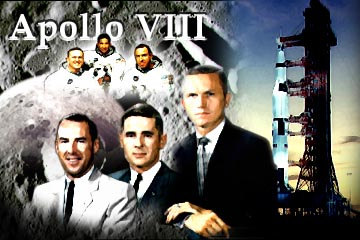
Apollo 8, the first manned mission
to the Moon, entered lunar orbit on Christmas Eve, December 24, 1968. That
evening, the astronauts; Commander Frank Borman, Command Module Pilot Jim
Lovell, and Lunar Module Pilot William Anders did a live television
broadcast from lunar orbit, in which they showed pictures of the Earth and
Moon seen from Apollo 8. Lovell said, "The vast loneliness is
awe-inspiring and it makes you realize just what you have back there on
Earth." They ended the broadcast with the crew taking turns reading from
the book of Genesis.
William Anders:
"For all the people on Earth the
crew of Apollo 8 has a message we would like to send you".
"In the beginning God created the
heaven and the earth.
And the earth was without form, and void; and darkness was upon the face
of the deep.
And the Spirit of God moved upon the face of the waters. And God said, Let
there be light: and there was light.
And God saw the light, that it was good: and God divided the light from
the darkness."
Jim Lovell:
"And God called the light Day,
and the darkness he called Night. And the evening and the morning were the
first day.
And God said, Let there be a firmament in the midst of the waters, and let
it divide the waters from the waters.
And God made the firmament, and divided the waters which were under the
firmament from the waters which were above the firmament: and it was so.
And God called the firmament Heaven. And the evening and the morning were
the second day."
Frank Borman:
"And God said, Let the waters
under the heavens be gathered together unto one place, and let the dry
land appear: and it was so.
And God called the dry land Earth; and the gathering together of the
waters called he Seas: and God saw that it was good."
Borman then added, "And from the
crew of Apollo 8, we close with good night, good luck, a Merry Christmas,
and God bless all of you - all of you on the good Earth
This spacecraft was the first of the
Apollo series to successfully orbit the moon, and the first manned spacecraft to
leave Earth's gravity and reach the Moon. The mission achieved operational
experience and tested the Apollo command module systems, including
communications, tracking, and life-support, in cis-lunar space and lunar orbit,
and allowed evaluation of crew performance on a lunar orbiting mission. The crew
photographed the lunar surface, both farside and nearside, obtaining information
on topography and landmarks as well as other scientific information necessary
for future Apollo landings. Additionally, six live television transmission
sessions were done by the crew during the mission, including the famous
Christmas Eve broadcast in which the astronauts read from the book of Genesis.
All systems operated within allowable parameters and all objectives of the
mission were achieved. The flight carried a three man crew: Commander Frank
Borman, Command Module Pilot James A. Lovell, Jr., and Lunar Module Pilot
William A. Anders.
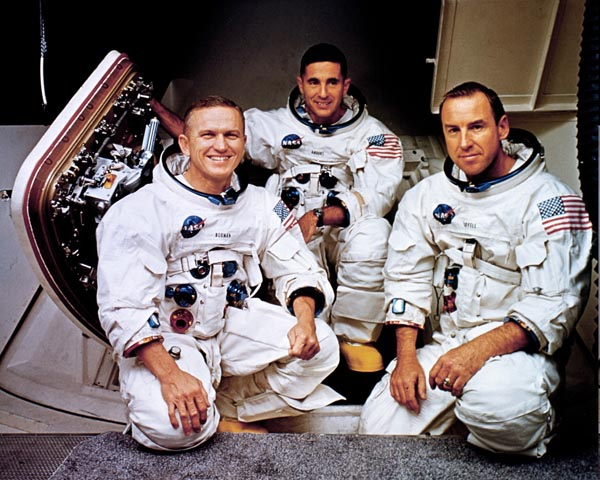
The Apollo 8 spacecraft consisted of a
command module similar to Apollo 7 except that the forward pressure and ablative
hatches were replaced by a combined forward hatch, which would be used for
transfer to the Lunar Module on later missions. The spacecraft mass of 28,817 kg
is the mass of the CSM including propellants and expendables. A Lunar Module was
not used on the Apollo 8 mission but a Lunar Module Test Article which was
equivalent in mass (9027 kg) to a Lunar Module was mounted in the
spacecraft/launch vehicle adapter as ballast for mass loading purposes.
The spacecraft was launched on December
21, 1968 at 12:51:00 UT (7:51 a.m. EST), and was placed in a 190.6 km x 183.2 km
Earth parking orbit with a period of 88.2 minutes and an inclination of 32.51
degrees. At 15:41:37 UT a third-stage burn injected the Apollo spacecraft into
translunar trajectory. Orbit insertion took place on 24 December at 09:59:20 UT
into an elliptical 310.6 km by 111.2 km lunar orbit. Two orbits later a second
burn placed Apollo 8 into a near-circular 110.4 by 112.3 km orbit for eight
orbits. The transearth injection burn took place on 25 December at 06:10:16 UT
after a total of 10 lunar orbits.
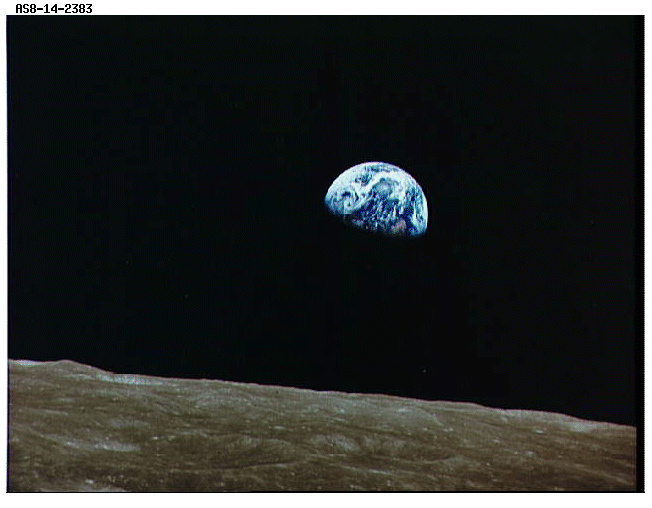
Apollo 8 splashed down in the Pacific Ocean on 27 December 1968 at 15:51:42 UT
(10:51:42 a.m. EST) after a mission elapsed time of 147 hrs, 0 mins, 42 secs.
The splashdown point was 8 deg 7.5 min N, 165 deg 1.2 min W, 1,000 miles SSW of
Hawaii and 5 km (3 mi) from the recovery ship USS Yorktown. The Apollo 8 Command
Module is on display at the Chicago Museum of Science and Industry, Chicago,
Illinois
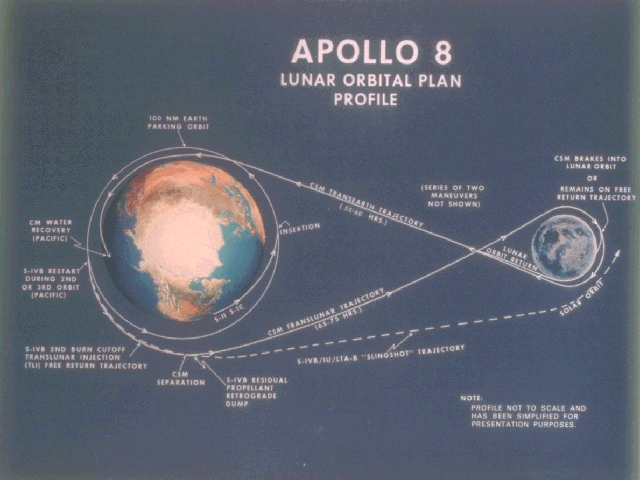
Mission Objective
The mission objectives for Apollo 8 included a coordinated performance of the
crew, the command and service module, or CSM, and the support facilities. The
mission also was to demonstrate translunar injection; CSM navigation,
communications and midcourse corrections; consumable assessment; and passive
thermal control. The detailed test objectives were to refine the systems and
procedures relating to future lunar operations.
All primary mission objectives and detailed test objectives were achieved. All
launch vehicle and spacecraft systems performed according to plan. Engineering
accomplishments included use of the ground network with onboard navigational
techniques to sharpen the accuracy of lunar orbit determination and the
successful use of Apollo high-gain antenna -- a four-dish unified S-band antenna
that deployed from the service module, or SM, after separation from the third
stage.
Mission Highlights
Apollo 8 launched from Cape Kennedy on Dec. 21, 1968, placing astronauts Frank
Borman, James Lovell Jr. and William Anders into a 114 by 118 mile parking orbit
at 32.6 degrees.
During the second revolution, at two hours, 50 minutes ground elapsed time, the
S-IVB third stage restarted for a five-minute, 17-second burn, initiating
translunar coast. Following S-IVB/CSM separation at three hours, 21 minutes, a
1.5 feet per second radial burn of the SM reaction control engines was initiated
to establish sufficient distance for S-IVB propellant dumping. Following the
propellant dumping, which sent the stage into diverging trajectory and solar
orbit, the separation distance still was deemed inadequate and a second SM
reaction control burn of 7.7 feet per second was performed.
The first midcourse correction occured at about 10 hours, 55 minutes into the
mission and provided a first check on the service propulsion system, or SPS,
engine prior to committing spacecraft to lunar orbit insertion. The second and
final midcourse correction prior to lunar orbit insertion occurred at 61 hours,
8 minutes, 54 seconds.
Loss of signal occurred at 68 hours, 58 minutes, 45 seconds when Apollo 8 passed
behind the moon. At that moment, NASA's three astronauts became the first humans
to see the moon's far side. The first lunar orbit insertion burn, at 69 hours, 8
minutes, 52 seconds, lasted four minutes, two seconds and reduced the
spacecraft's 8,400 feet per second velocity by 2,994 feet per second, resulting
in an initial lunar orbit of 70 by 193 miles. The orbit circularized at 70 miles
by the second lunar orbit insertion burn of 135 feet per second, performed at
the start of the third revolution, again on the back side of the moon, at 73
hours, 35 minutes, five seconds.
During the 20-hour period in lunar orbit, the crew conducted a full, sleepless
schedule of tasks including landmark and landing site tracking, vertical stereo
photography, stereo navigation photography and sextant navigation. At the end of
the 10th lunar orbit, at 89 hours, 19 minutes, and 16 seconds, a three-minute,
23-second trans-Earth injection burn was conducted, adding 3,522 feet per
second. Only one midcourse correction, a burn of five feet per second conducted
at 104 hours, was required instead of the three scheduled.
Six telecasts were conducted during the mission: two during translunar coast,
two during lunar orbit and two during trans-Earth coast. These transmissions
were telecast worldwide and in real time to all five continents. During a
telecast on Christmas Eve, the crew read verses from the first chapter of
Genesis and wished viewers, "Good night, good luck, a Merry Christmas and God
bless all of you -- all of you on the good Earth." All telecasts were of
excellent quality. Voice communications also were exceptionally good throughout
the mission.
Separation of the command module, or CM, from the SM occurred at 146 hours, 31
minutes. A double-skip maneuver conducted during the re-entry steering phase
resulted in an altitude gain of 25,000 to 30,000 feet. The re-entry velocity was
24,696 mph, with heatshield temperatures reaching 5,000 degrees F. Parachute
deployment and other re-entry events were nominal. Apollo 8 splashed down in the
Pacific Ocean at 10:51 a.m. EST Dec. 27. The splashdown was about 5,100 yards
from the recovery ship USS Yorktown, 147 hours after launch and precisely on
time. According to prior planning, helicopters and aircraft hovered over the
spacecraft, and pararescue personnel were not deployed until local sunrise, 50
minutes after splashdown. The Apollo 8 crew reached the recovery ship at 12:20
p.m. EST.
Credit NASA
|







